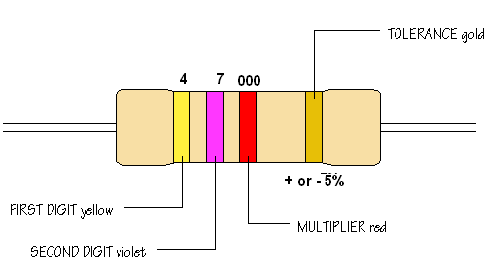Resistors are passive electronic components mainly used for controlling flow of electric current and providing desired amount of voltage in electronic circuits. The circuit element, which introduces electrical resistance into the circuit is called resistor. If the electrical values are going to be constant, it is a fixed resistor. If the values of electrical resistance are adjustable, it is variable resistor (e.g. Rheostat & potentiometer).
Resistance colour code system:-
Brown = 1%
Red= 0.1%
Orange= 0.01%
Yellow= 0.001%
| Colour | First Digit | Second Digit | Decimal Multiplier | Tolerance |
| Black | 0 | 0 | 100 | – |
| Brown | 1 | 1 | 101 | – |
| Red | 2 | 2 | 102 | – |
| Orange | 3 | 3 | 103 | — |
| Yellow | 4 | 4 | 104 | – |
| Green | 5 | 5 | 105 | – |
| Blue | 6 | 6 | 106 | – |
| Violet | 7 | 7 | 107 | – |
| Grey | 8 | 8 | 108 | – |
| White | 9 | 9 | 109 | – |
| Gold | – | – | – | 5% |
| Silver | – | – | – | 10% |
| No Colour | – | – | – | 20% |
Table 1 : Color codes.
First three rings gives value of resistor, while last ring gives tolerance range in which the value of that resistor may lie.
For e.g. Bands of resistors are,
Brown Red Orange Gold
1 2 *103 with 5%tolerance
= 12*103Ω with 5%tolerance
The resistors are roughly classified into
1. Fixed resistors
2. Variable resistors
3. Film resistors
Fixed Resistors: A fixed resistor is a two terminal resistor whose electrical resistance is constant. There are three basic types of fixed resistors as follows:
1. Carbon composition resistors.
2. Wire wound resistors.
3. Metal film resistors.
Carbon composition resistors: These are the common low wattage fixed type resistor. Resistive material used is of carbon day composition. The leads are made up of timed copper.
1. Resistance range: 2.7Ω to 2MΩ
2. Tolerance : 5%, 10%, 20%
3. Operating temp. range: -550c to +1500c
4. Power rating : 1/8w, 1/4w, 1w,2w
Wire wound resistors: When higher power rating is required, these resistors are used. This resistor is wound with single layer, single element of high resistance wire on ceramic rod substrate. This wire is weld to end caps & leads are attached.
1. Resistance range: 0.1Ω to 117KΩ
2. Tolerance : 5%
3. Operating temp. range: -550c to 3750c
4. Power rating : 1/8w, 1/4w, 1/2w, 1w,2w
Film resistors: In this type of resistor a thin layer of a resistive material is put up on a ceramic or glass rod.
1. Resistance range: 1Ω to 100MΩ
2. Tolerance : 1%, 2%, 5%,
3. Operating temp. range: 1550c to +1650c
4. Power rating : 1/8w, 1/4w, 1/2w
CARBON FILM
The most popular resistor type.
This resistor made by depositing a carbon film onto a small ceramic cylinder. A small spiral groove cut into the film controls the amount of carbon between the leads, hence setting the resistance. Such resistors show excellent reliability, excellent solderability, noise stability, moisture stability, and heat stability. Typical power ratings range from 1/4 to 2 W.
Resistances range from about 10 Ohm to 1 MOhm, with tolerances around 5 percent.
CARBON COMPOSITION
This type is also popular. Its made from a mixture of carbon powder and glue like binder. To increase the resistance, less carbon is added. These resistors show predictable performance, low inductance, and low capacitance. Power ratings range from about 1/4 to 2 W. Resistances range from 1 Ohm to about 100 MOhm, with tolerances around +/- 5 percent.
VARIABLE RESISTORS
Variable resistors provide varying degrees of resistance that can be set with the turn of a knob. Special kinds of variable resistors include potentiometers, rheostats, and trimmers. potentiometers and rheostats are essentially the same thing, but rheostats are used specially for high power AC electricity, whereas potentiometers typically are used with lower level DC electricity. Both potentiometers and rheostats are designed for frequent adjustment. Trimmers, on the other hand, are miniature potentiometers that are adjusted infrequently and usually come with pins that can be inserted into pcb. They are used for fine tuning circuits (eg. : fine tuning a circuit that goes astray as it ages), and they are usually hidden within a circuits enclosure box. Variable resistors come with 2 or 3 terminals
